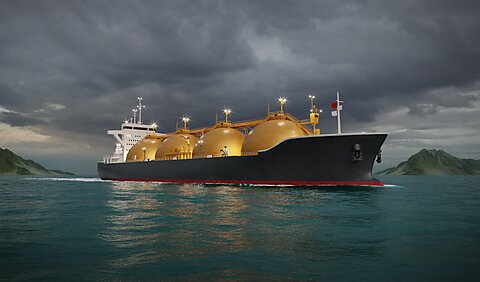
Travis Fisher
On January 26, the Biden administration announced it would pause new approvals of liquefied natural gas (LNG) exports. The official news followed several leaked stories—including one prominent article by The New York Times—that triggered criticism from LNG supporters and praise from climate activists.
The announcement appears to be a concession to the “keep it in the ground” movement and the 65 federal lawmakers who asked for the policy change in November 2023. However, some pragmatic progressives see the pause as misguided: “The urgency of the energy transition cannot excuse counterproductive purity tests,” wrote Elan Sykes and Neel Brown of the Progressive Policy Institute.
From the libertarian perspective, the pause is unwise energy policy, an encroachment on free trade, and a continuation of the Biden administration’s use of uncertainty as a political weapon against energy suppliers. Let’s dig in.
What Is Changing, Exactly?
LNG is the liquefied version of natural gas (mostly methane, CH4). Shippers cool the gas to approximately negative 260 degrees Fahrenheit to make it a liquid that is portable via tanker ships. International trade in LNG has spiked in part because of the abundant natural gas resources in the United States, which were enabled by technological improvements in unconventional production from shale formations.
The United States did not export significant quantities of LNG until about 2015, so one might say the industry is in uncharted waters. The aggressive growth in LNG exports (particularly relative to historic levels of imports) can be seen in the graph below.
(Source.)
Although the large quantities of exports are new, the legal apparatus is not. Specifically, under the Natural Gas Act (NGA), the Department of Energy (DOE) must approve any import or export of natural gas. Congress passed the NGA in 1938, so the statute predates the organization of the DOE itself, which was formed by Congress in 1977 by the DOE Organization Act.
Before the DOE was established the responsibilities in this section of the NGA were carried out by the Federal Power Commission (renamed in 1977 to the Federal Energy Regulatory Commission or FERC). Now the two agencies each regulate different parts of the LNG industry. DOE explains their roles as follows:
The NGA directs DOE to evaluate applications to export LNG to non‐FTA [Free Trade Agreement] countries. … Typically, the Federal Energy Regulatory Commission (FERC) has jurisdiction over the siting, construction, and operation of LNG export facilities in the US In these cases, FERC leads the environmental impact assessments of proposed projects consistent with the National Environmental Policy Act, and DOE is typically a cooperating agency as part of these reviews. Obtaining a DOE authorization to export LNG to non‐FTA countries is an important step for most projects in their path toward financing and construction.
The Biden administration said the DOE will now scrutinize applications to export LNG through the lens of climate change and other factors in determining whether additional US LNG exports are in the public interest. The White House stated:
The current economic and environmental analyses DOE uses to underpin its LNG export authorizations are roughly five years old and no longer adequately account for considerations like potential energy cost increases for American consumers and manufacturers beyond current authorizations or the latest assessment of the impact of greenhouse gas emissions. Today, we have an evolving understanding of the market need for LNG, the long‐term supply of LNG, and the perilous impacts of methane on our planet.
The DOE has never denied an LNG export application, so this is a big shift in public policy.
Who Carries the Burden of Proof?
The rise of low‐cost natural gas production in the United States—combined with high prices and resource constraints in other parts of the world—means US producers can profitably refrigerate, ship, and deliver gas to other countries. In contrast to other energy resources that require mandates and subsidies, LNG exports merely require approval from the federal government. All the government has to do is get out of the way.
The text of the NGA establishes approval as the default position. The statute says the DOE “shall” issue an order approving a project “unless, after opportunity for hearing, it finds that the proposed exportation or importation will not be consistent with the public interest.” Hence a pause to further consider new factors is the wrong posture—LNG approvals should continue until and unless DOE makes a new finding that LNG exports are inconsistent with the public interest. Ideally, of course, the government shouldn’t have the power to bar energy exports in peacetime.
There is a case to be made on either side of the climate debate regarding LNG.
Supporters of LNG exports cite the lower CO2 emissions of natural gas combustion over coal. By exporting natural gas and displacing the use of coal globally, the argument goes, the United States can help other countries reduce their CO2 emissions. We have certainly seen coal‐to‐gas switching bring down emissions in the United States.
Opponents of LNG exports, however, argue that the energy required to cool and transport natural gas—not to mention leakage of uncombusted methane, itself a potent greenhouse gas—makes it little better for climate change than burning coal.
The Administration’s Action is Arbitrary and Capricious
As experts debate the net impact of natural gas exports on factors like global climate change, the structure of the NGA indicates that approvals should move forward while the DOE deliberates. In July 2023, the DOE rejected a petition by environmental groups to do precisely what it now accepts—to undertake a blanket review of its LNG policy.
In fact, the DOE’s rejection notes in the first sentence of the document that the Administrative Procedure Act (APA) provides that each agency “shall give an interested person the right to petition for the issuance, amendment, or repeal of a rule.” The DOE’s new policy of a “pause” runs afoul of the APA and deprives interested parties the ability to challenge it before it goes into effect.
The new stated policy of a pause is especially capricious—meaning impulsive or unpredictable—given how the DOE responded to the environmental petitioners just six months ago:
After carefully considering Petitioners’ request, DOE is denying the Rulemaking Petition. As discussed below, DOE has reasonably exercised its discretion to implement its LNG export program through a combined approach of individual adjudications and export‐focused regulatory actions, rather than a single rulemaking of broad applicability. DOE‘s existing LNG export regulatory program is responsive to Petitioners’ principal concerns—namely because, since 2013, DOE has, in fact, established a decision‐making process under NGA section 3(a) that “respond[s] to the complex issues raised by LNG export and appropriately serve[s] the Natural Gas Act,” as Petitioners request. (emphasis in original)
How can the DOE now claim that it does not need to go through a formal rulemaking process in reversing course and implementing a new LNG approval regime? Even the environmental groups that want the DOE to shut down LNG exports should agree that their petition for a new rulemaking was the appropriate vehicle for enacting new policy.
Further, in the event of an administrative policy change at DOE that rises to the level of national significance—I think an indefinite LNG export pause qualifies—the Supreme Court’s “Major Questions Doctrine” should come into play. As the Congressional Review Service summarized the doctrine, “if an agency seeks to decide an issue of major national significance, its action must be supported by clear congressional authorization.” (emphasis in original) Did Congress give the DOE clear authorization to deny LNG export applications based on the factors DOE now finds important?
Political Uncertainty as Punishment
We have already seen the playbook of capricious policy in action. In February 2022, FERC issued new policy statements “providing guidance for future consideration of natural gas projects by the Commission.” The policy change—which suggested that an unspecified level of climate mitigation would be necessary to serve the public interest and receive FERC approval of gas pipeline projects—injected enormous uncertainty into the pipeline approval process.
The concept of the February 2022 policy statement was also the subject of a series of rebuttals (prebuttals?) by Commissioner Bernard McNamee, who argued forcefully beginning in 2019 that “the commission does not have the authority under the NGA or [the National Environmental Policy Act] to deny a pipeline certificate application based on the environmental effects of the upstream production or downstream use of natural gas nor does the commission have the authority to unilaterally establish measures to mitigate” emissions.
Ultimately, FERC withdrew its proposal after receiving blistering blowback from members of the Senate Energy and Natural Resources Committee (ENR). Senator Joe Manchin (D‑WV), ENR chairman, said FERC was “constructing additional road blocks that further delay building out the energy infrastructure our country desperately needs.” Delay is the practical impact of political uncertainty.
The Environmental Protection Agency (EPA) appears to be using the same strategy. Last year, the EPA proposed in its power plant rulemaking to mandate two unproven technologies—green hydrogen and carbon capture—for new or reconstructed power plants to meet greenhouse gas emission targets. The EPA proposed that “affected sources that commenced construction or reconstruction after May 23, 2023” would need to meet the requirements of the final rule.
The electricity generation industry remains in the middle of the uncertainty caused by the EPA’s unworkable proposal. For any new or reconstructed natural gas‐fired power plant (affected source) subject to EPA’s new standard, a company can construct the unit today and be held—at some future date—to a standard that does not yet exist and may be impossible.
Given the recent track records at DOE, FERC, and EPA, crippling uncertainty is beginning to look like the aim of energy policy rather than an unfortunate side effect.
LNG Export Pause Offers a Lesson in Economic Thinking
The White House listed “potential energy cost increases for American consumers and manufacturers” as one justification for the LNG pause. It is true that, in the very short term, an announcement that the federal government will forcibly restrict the export of natural gas would likely cause its domestic price to fall. But, as French economist Frederic Bastiat implored, we should attempt to foresee long‐term impacts. Bastiat wrote:
There is only one difference between a bad economist and a good one: the bad economist confines himself to the visible effect; the good economist takes into account both the effect that can be seen and those effects that must be foreseen.
Yet this difference is tremendous; for it almost always happens that when the immediate consequence is favorable, the later consequences are disastrous, and vice versa. Whence it follows that the bad economist pursues a small present good that will be followed by a great evil to come, while the good economist pursues a great good to come, at the risk of a small present evil.
Restricting the sale of LNG abroad would send ripple effects up the supply chain, blunting incentives to explore for more natural gas and to produce what’s already been found. Advocates of thwarting the global natural gas trade—and of hoarding domestic natural gas—are focused on temporary, short‐term impacts to commodity prices and ignoring long‐term impacts to natural gas supply infrastructure.
Whose Gas Is It Anyway?
Economics aside, what business does the federal government have in dictating the direction of an industry that delivers a product that so many people find valuable? Advances in directional drilling and hydraulic fracturing technology (commonly referred to as “fracking”) allowed American firms to produce astonishing amounts of useful energy from hydrocarbons trapped over a mile deep in rock formations. (Turn useless, 6,000-foot-deep rock into electricity? Yes, please.)
People here and abroad want to use that energy. Natural gas is a valuable resource—we use it not just to fuel power plants but to cook food, heat homes, and fabricate a dizzying array of plastics, fibers, and even medicines. Natural gas liquids like propane and ethane are especially useful as a material feedstock but also have energy‐related applications.
The DOE, EPA, and FERC may try to stifle the progress of the natural gas industry in the name of climate change (or industry protectionism), but the demand for energy will always be there. Globally, energy consumption continues to increase, as shown below.
(Source.)
The challenge to meet growing demand should be exciting because energy consumption reflects the increasing living standards of countless millions (hopefully billions) across the globe. The US Energy Information Administration stated in its 2023 International Energy Outlook: “as incomes and population rise over time, energy consumption increases as more people can afford to drive, use commercial services, demand goods, and control building temperatures.”
For the hundreds of millions of people worldwide who still lack access to electricity, LNG exports could be the difference between dark and light.





